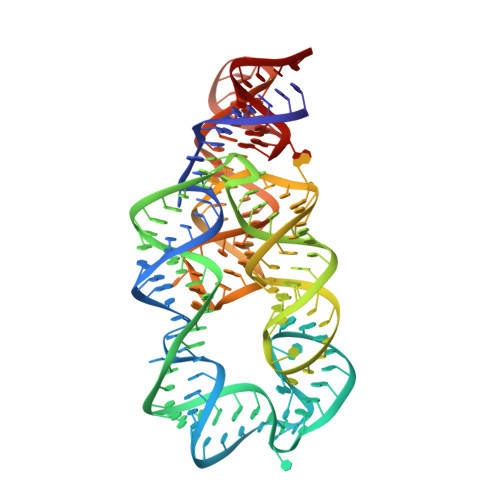Insights into the regulatory landscape of the lysine riboswitch.
Garst, A.D., Porter, E.B., Batey, R.T.(2012) J Mol Biol 423: 17-33
- PubMed: 22771573
- DOI: https://doi.org/10.1016/j.jmb.2012.06.038
- Primary Citation of Related Structures:
4ERJ, 4ERL - PubMed Abstract:
A prevalent means of regulating gene expression in bacteria is by riboswitches found within mRNA leader sequences. Like protein repressors, these RNA elements must bind an effector molecule with high specificity against a background of other cellular metabolites of similar chemical structure to elicit the appropriate regulatory response. Current crystal structures of the lysine riboswitch do not provide a complete understanding of selectivity as recognition is substantially mediated through main-chain atoms of the amino acid. Using a directed set of lysine analogs and other amino acids, we have determined the relative contributions of the polar functional groups to binding affinity and the regulatory response. Our results reveal that the lysine riboswitch has >1000-fold specificity for lysine over other amino acids. The aptamer is highly sensitive to the precise placement of the ε-amino group and relatively tolerant of alterations to the main-chain functional groups in order to achieve this specificity. At low nucleotide triphosphate (NTP) concentrations, we observe good agreement between the half-maximal regulatory activity (T(50)) and the affinity of the receptor for lysine (K(d)), as well as many of its analogs. However, above 400 μM [NTP], the concentration of lysine required to elicit transcription termination rises, moving into the riboswitch into a kinetic control regime. These data demonstrate that, under physiologically relevant conditions, riboswitches can integrate both effector and NTP concentrations to generate a regulatory response appropriate for global metabolic state of the cell.
Organizational Affiliation:
Department of Chemistry and Biochemistry, University of Colorado at Boulder, 596 UCB, Boulder, CO 80309-0596, USA.
















